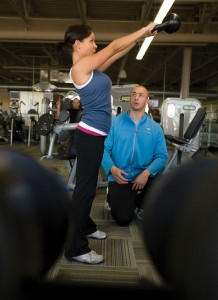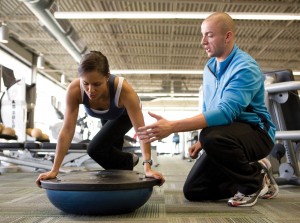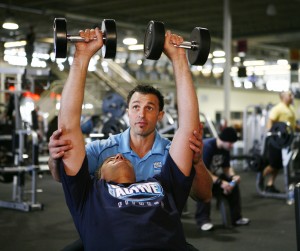 Personal Training has become a necessity within the industry that can yield big profits to a club’s bottom line. Many clubs within the industry attribute anywhere from 15 to 30 percent of their revenue to personal training – not offering personal training would be the equivalent to throwing money down the drain.
Personal Training has become a necessity within the industry that can yield big profits to a club’s bottom line. Many clubs within the industry attribute anywhere from 15 to 30 percent of their revenue to personal training – not offering personal training would be the equivalent to throwing money down the drain.
It’s safe to say that most clubs throughout the U.S. offer personal training or some form of training to their members. They have seen the desire from their members to look good and stay motivated, and through personal training, clubs have found a way to give individual guidance to gain extra revenue and put smiles on members’ faces. Urban Active, which currently has 400 personal trainers among their 37 clubs, specializes in their own brand of personal training called Urban Active Body Shaping. “We sell 12-month programs with a monthly continual 90 to 95 percent of the time,” said Josh Pride the vice president of personal training at Urban Active. “Clients have the option to pay in full and use those sessions any way they would like. Otherwise, we have a predetermined schedule of training frequency that the client must follow if they decide to pay monthly. Between 25 and 30 percent of our company’s total business comes from personal training. It has made an enormous impact on our business and it has allowed us to expand quicker to areas we didn’t consider five years ago.”
Although Anytime Fitness acts as a franchisor, Debra Griffith, the Coach to Inspire, Franchisee Support for Anytime Fitness, said that they strongly encourage their franchisees to implement personal training into their clubs. “The impact of personal training on a business is directly related to the amount of energy a club owner puts into the training program at their club,” she said. “Our clubs can range from very little attention to small clubs making $30,000 a month on personal training.”
Sport&Health in Washington, D.C. has felt the same surge with their personal training programs. “It contributes about 14 percent of revenues,” said Mitch Batkin, the senior vice president of fitness at Sport&Health. “Equally important is how PT helps the retention of members. They stay much longer and refer more people since they are pleased with their experience at our clubs.”
Success for personal training programs is dependent on the club’s owner or general manager and how much effort is put into marketing their innovative programs to members and potential members. Clubs can market for different types of programs and get members involved in short seminars when they first join to make members aware of the personal training programs offered.

Marketing for personal training won’t be like marketing for anything else in the club. Unlike other aspects, simply discussing the benefits won’t work. Clients will perceive the marketing campaigns as a way to pull more money out of their pockets. In order to avoid this type of resentment from members towards the club, try using member testimonials to tell the story. Josh Bowen, the quality control director of personal training for Urban Active explained that all new members receive a complimentary personal training assessment and many of Urban Active’s members choose to continue with their services after the assessment. “Testimonials are best for marketing personal training,” he said. “Also, marketing the exact services a personal trainer will provide, such as exercise programming, nutritional counseling and corrective exercise are all great ways to market personal training to members. We have seen a significant uptick in external and internal revenue when marketing personal training using e-mail blasts to members, mailers, as well as internal signage that present the options of our personal training department.”
Another important aspect of great PT marketing is by knowing where the club is located. Clubs that market PT programs to stay-at-home mom’s won’t be successful if they are located in the heart of a major metropolitan city, and marketing for the business professional won’t be successful in a small Mid-Western town. “We coach our franchisees different in different markets,” Griffith said. “In urban markets, or areas educated on personal training, the marketing really is to hire quality trainers and make them visible to members. In rural markets, where no one knows what a personal trainer does, except make you unable to walk the next day, then you will have to move more methodically into the process and begin with educating members on what exactly you use a trainer for.
“Some ways to market to an uneducated clientele is to start by narrowing down what the training can be used for – six sessions for golf conditioning, six sessions for ski conditioning, 30 minutes of core conditioning or 12 sessions to get your body ready for spring break. This lets the member know exactly what they will be working towards.”
Clubs have to market for aspects of personal training that can get members and potential members excited. Personal trainers can implement products like dotFit and exercises taken from Pilates and Yoga classes. “The dotFIT platform is designed specifically with the solution-oriented trainer in mind,” said Christie Renick, the web-marketing manager for dotFIT. “Trainers have access to their own personal dotFIT programs 24 hours a day, which gives them the unique ability to show their clients and prospective clients that they too ‘walk their talk,’ which in turn increases the rapport between the trainer and their client.”
“Many club and fitness facilities are beginning to augment traditional personal training with specialty one-on-one sessions in areas such as Pilates, Core Training and Functional Training,” said Lindsay Merrithew, the CEO and president of STOTT PILATES® “With over 10 million people participating in Pilates worldwide, club owners are beginning to recognize the benefits of offering Pilates to their members as an additional personal training service.” When exercises, such as Pilates and Yoga, become popular, clubs can use them to their advantage and get personal trainers involved, creating a spike in personal training business.
Basically, the idea behind marketing for personal training is to get members more comfortable in the fitness atmosphere. The more comfortable they are within the club, the more time they will spend trying to get the toned physique they are searching for. Using personal trainers, in many cases, is the only way for members to reach those goals. Many clubs host informative meet and greets with their trainers. In these settings, members can listen to the training department and learn exactly what they do on a daily basis. They can make contact with trainers and potentially find one that works well for them. Also, these meet-and-greet settings will give members another comfortable face when they are inside the club.

Trainers have started using products such as Indo Boards and TRX systems to help multiple clients simultaneously. “Personal training offers a great vehicle for customer service to a club,” said Hunter Joslin, the president of Indo Board. “One-on-one interaction and small group classes are opportunities for clubs to offer members a rewarding and interesting exercise experiment. The Indo Board offers clubs a space saving and injury free balance training apparatus. The clubs can promote these programs using surfing and snowboarding as catch phrases to attract action sports enthusiasts and members who want a new and interesting exercise experience.”
“It is in the interest of fitness facilities to build communities and for their trainers to aid them in doing so,” said Jeffrey Perlman, the vice president of marketing at Zumba. “Personal trainers need to be much more than personal trainers. They need to be friends, peers and leaders that bring communities together and help gyms attain higher levels of retention. Clubs are finding that through the Zumba fitness-parties, they can dramatically increase their member retention rates.”
In order to have personal training executed with the utmost precision, personal trainers should all be certified by reputable certification companies. “We only accept the top eight nationally recognized and accredited certifications,” Pride said. “All certifications are not created equal and we want to hire the most qualified individual that has the knowledge and application to service our members at a high level. The certifications that we accept are time tested and are based around educating the best trainer possible.”
By having educated personal trainers working with members, the members are guaranteed to have a new and enjoyable experience. They will feel that what they are being taught is accurate and will surely see results. “It’s important to know that someone that is working on our members is qualified and will continue to go through education courses in order to stay certified,” Griffith said.
The National Exercise Trainer Association (NETA) has helped clubs keep trainers up-to-date for years. Also, they provide classes and workshops to help get newly hired trainers ready to host clients. “NETA makes it easy for club managers,” said Mario Crespo, the president of NETA. “Hosting a NETA workshop is a great recruiting tool. It gives host clubs the opportunity to attract and train new people. Also, since NETA advertises the workshops, it provides additional exposure for the facility.”
“Educated fitness professionals provide a depth of service that is not only appreciated and respected by members, but a documented trend in the industry,” said Richard T. Cotton, M.A., the national director of certification for ACSM. “More than ever, certified trainers are working with clients to achieve lifelong behavior change. While creating quality exercise programs and associated workouts are important, supporting a client in making lifestyle change is the true return on investment for both the client and the club.”
Personal training can completely change the member’s perception of the club and possibly influence their passion for working out in general. “In tough economic times, enlightened people realize that health is not an area to cut expenses in,” Griffith said. “That being said, while they will not give training up, they may cut back on the number of times per week. Trainers need to be more proactive on continuing to sell versus relying on current client base. Small group training has become more popular and can benefit both the client and trainer because the client pays less and the trainer can make the same or more for that session with more clients.”
“Trainers are going to have to find ways to handle multiple clients in an efficient yet personalized manner,” said David Chapman, the president of Fit Express. “I see it as more of a cross between conventional personal training methods and group exercise.” Chapman contributes the changes in personal training to the influx in baby boomers that exercise.
“With the changing demographics, personal trainers are going to have to be able to accommodate both the needs and wants of these individuals while facing a different challenge due to their physical limitations,” Chapman said. “Safety will increase in importance as well as finding more user friendly ways to accommodate the needs of this market. Finding a way to make it more fun and social is also important to these folks.”
Sara Jespersen, the content director with Fitness On Request believes personal trainers need some light assistance when working with multiple clients. “Fitness on Request is specifically designed with flexibility and variety in mind,” she said. “For personal trainers who focus on strength-training in their one-on-one sessions, they can prescribe cardio classes for their clients own time. Clients can fit it into their schedules conveniently.”
“With obesity, diabetes, and lower back pain at an all time high, personal trainers are now specializing in corrective exercise, functional training and weight management. Corrective exercise has become a new trend in the personal training world, with the American work force consisting of mostly sedentary jobs, correcting clients pain and muscular imbalances has become paramount,” said Bowen.
As great as all this sounds, there are some things to watch out for. One of the most important aspects of personal training can involve insurance surrounding the club in general. According to Lorena Hatfield, the marketing resource manager for K&K Insurance Group, a lot of club insurance companies don’t cover personal trainers. In fact, many clubs require personal trainers to insure themselves in order to train at the club.
Personal training could be the greatest asset to a club. If it is employed properly, it can change the entire perception from members and prospects alike. However, there are several things to watch for when trying to implement personal training. Always pay attention to the certification of each individual trainer. “The overall benefit of certification is the establishment of a measurable standard for quality assurance,” said Angie Pattengale, the director of certification for NFPT. “It all starts with certification.” If the club hires reputable trainers, members will receive greater results and the club will begin to attract new clients by the masses. Also, don’t forget about finding trainers who are willing to think outside the box. There are so many new ways to train members, both in classes and individually – don’t forget about different training methods, Indo Boards, TRX and other types of resistance training.
Most importantly, don’t forget to either insure each trainer or make sure they insure themselves. This isn’t so the trainer appears more reputable or interacts better with clients, but it’s to save the trainer and the club from any type of lawsuit or anything else that could harm the club’s overall reputation. Personal training could be a moneymaker this year, but everything still has to be performed properly to receive amazing results, just like in training. –CS








